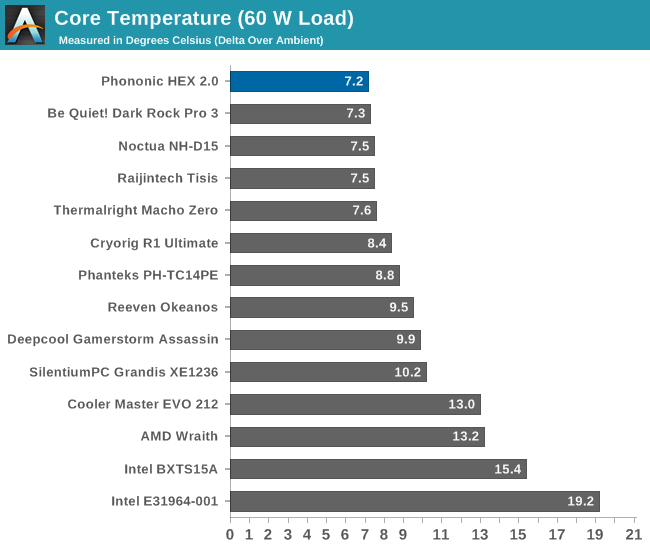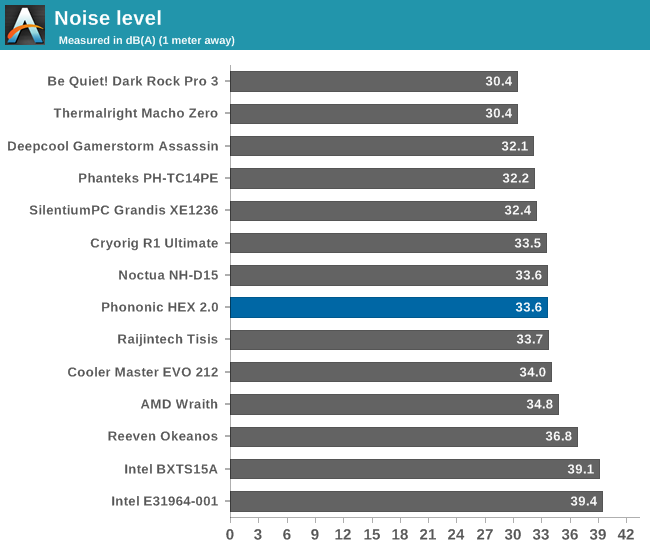The Phononic HEX 2.0 TEC CPU Cooler Review
by E. Fylladitakis on September 26, 2016 9:30 AM EST- Posted in
- Cases/Cooling/PSUs
- Cooler
- TEC
- Phononic
- HEX 2.0
Testing results, low fan speed (7 Volts)
Note that the voltage refers only to that of the fan, the TEC requires a constant 12V supply.


| Core Temperature, Constant Thermal Load (Low Fan Speed) |

The advantage of using a TEC at lower thermal loads becomes more apparent when the cooler fans are running at a reduced speed. Here we see that the performance of the HEX 2.0 was only slightly affected by the change of the fan’s speed under a thermal load of 60W, registering a thermal resistance of 0.1200 °C/W, a value comparable only to that of the best air coolers available. However, once again, the thermal performance of the HEX 2.0 degrades sharply as the thermal load increases, especially for thermal loads above 200W. With a thermal load of 340W, the thermal resistance of the HEX 2.0 is only 0.2506 °C/W, a very poor value that only outperforms low range and stock coolers.

In terms of acoustics performance, the 92 mm fan of the HEX 2.0 is virtually noiseless under these operating conditions. Our instruments recorded 33.6 dB(A) from a distance of one meter, only 3.2 dB(A) higher than our floor noise level. It will not be easily discernible by human ears inside a normal room, but it can be discerned if someone focus on the task.










48 Comments
View All Comments
saratoga4 - Monday, September 26, 2016 - link
>Note that a large percentage of this energy consumption is inserted as additional thermal load for the cooler to dissipate.All of it should show add to the air cooler load. Energy is conserved.
ImSpartacus - Monday, September 26, 2016 - link
This is one of those times where you're reminded why coolers use the tech that they use. It seems to be tough to beat.Good review though. Always interesting to see new things.
LordOfTheBoired - Tuesday, September 27, 2016 - link
Honestly, in this case it seems like poor design decisions.They went with an unusually small fin stack, and thus unusually limited heat dissipation area, for a cooler design that needed to dissipate more heat than the norm.
evilpaul666 - Wednesday, September 28, 2016 - link
I was surprised to see this review when I popped in today. I'd recently remembered the TECs of the early 2000s and wondered, "Whatever happened to those?" Back in the day they were too expensive and poorly controlled so condensation was a serious risk.The latter seems to be addressed by this product, but having just picked up an AIO 480mm water cooling solution for slightly less money than the older ones I looked up that were still listed on Newegg/Amazon this one is still a bit more expensive although it solves the MASSIVE heatsink that won't fit into most cases problem that older TEC solutions had. Possibly to its detriment as the performance doesn't scale great. That might be fixed by different design decisions like you mentioned.
Demi9OD - Monday, September 26, 2016 - link
I ran a TEC with a water cooler way back in the day on my Pentium 3. Condensation was awful, I needed a catch under my CPU for the dripping water.BrokenCrayons - Monday, September 26, 2016 - link
I had severe condensation problems with a TEC cooler I purchased at a computer show on an AMD K6-3. It didn't ruin the motherboard, but when I pulled the cooler off to check on things after running one for a couple of days the trench around the rim of the heat spreader was filled with water and the underside of the chip was damp. It didn't offer any additional overclocking headroom either, which was what I purchased it for to begin with. It was a 400MHz chip and I never got it to reliably hit 450. After discovering the condensation, I popped my cheap air cooler back on the chip and never looked back.Samus - Monday, September 26, 2016 - link
Alas, I had condensation issues with my peltier/liquid cooling on my Athlon slot-A which left some options to address over a socketed CPU, but still did something dramatically different to address it.I moved the peltier to the water reservoir, installing a heat sink/fan on the peltier. The water reservoir was made of copper so the chilling effect conducted well and this dropped the water temperatures to sell below ambient.
This system worked awesome for a long time until one day my water pump failed. Yep, the water got so cold it froze. I didn't out antifreeze or anything in, opting for wetter water instead because of its better high temp properties.
Marlowe - Wednesday, September 28, 2016 - link
Samus: That's actually really smart. Although in retrospect you should've applied some antifreeze :-) In what way do you think can a modern AIO water solution incorporate a peltier element?Bigman397 - Friday, September 30, 2016 - link
A new class of AIO cooler that has an external reservoir/fin stack with a peltier? Seems like an interesting idea. I always figured if I went to the lengths of making a big custom watercooler set I would use a multi-loop system with a heat exchanger, obviously ridiculous in a practical sense but fun to theorize.Stuka87 - Sunday, October 2, 2016 - link
Another option is to have the peltier on an adjustable voltage slope. When the CPU is idle, it doesn't do much. But as temps increase, it too increases. That way you kind of have the best of both worlds.